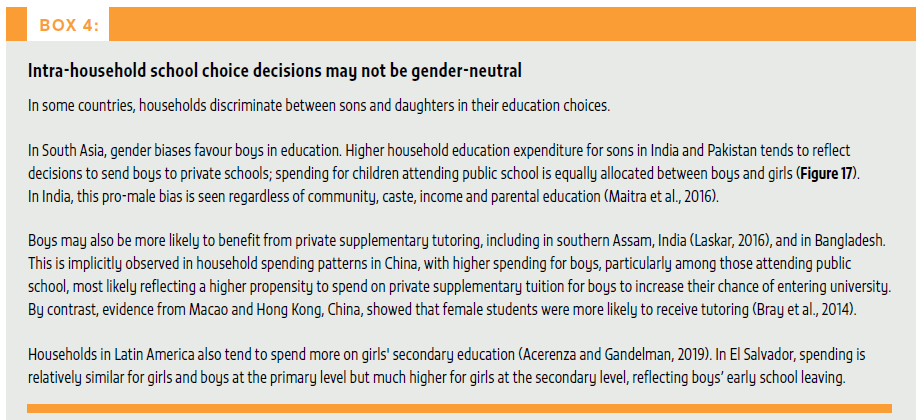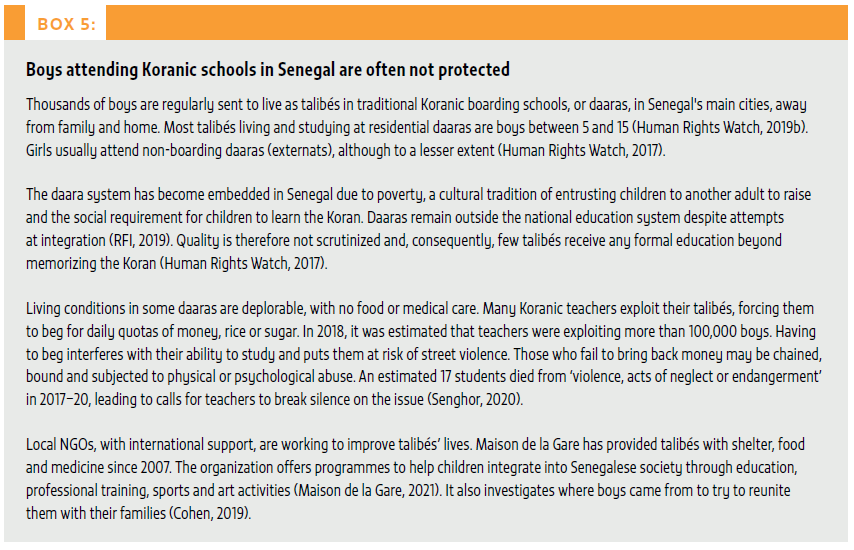Non-state actors often preserve gender barriers in primary and secondary education
2022 Gender Report
CREDIT: Tarik Abdel-Monem
The UIS is the main source of data on enrolment in public and private institutions. It defines private education institutions as those that are ‘not operated by a public authority but controlled and managed, whether for profit or not, by a private body (e.g. non-governmental organization, religious body, special interest group, foundation or business enterprise)’. The share of private institutions worldwide increased by 7 percentage points in about 10 years, from 10% in 2002 to 17% in 2013 in primary education and from 19% in 2004 to 26% in 2014 in secondary education, but has since remained roughly constant. As of 2020, the share stands at 19% in primary and 27% in secondary education.
There is significant regional variation. Central and Southern Asia is the region with by far the highest share of private enrolment: 36% in primary and 48% in secondary education in 2019. The share generally does not exceed 20% in other regions. Central and Southern Asia has also experienced the largest absolute increases since 2000. The fastest increases in primary education private enrolment, with shares doubling or more, were observed in Northern Africa and Western Asia and in Eastern and South-eastern Asia, though the shares in both regions remained among the world’s lowest at about 10%. Europe and Northern America had the lowest rate of increase in primary private enrolment (remaining constant at about 10%) but the highest rate of increase in secondary private enrolment (from 9% in 2006 to 15% in 2014). The share of private institutions grew more slowly than the global average in sub-Saharan Africa and in Latin America and the Caribbean.
Interesting gender patterns in enrolment in private institutions can be observed. Globally, slightly more boys than girls are enrolled in private institutions at both the primary level (a gap of 1.5 percentage points) and the secondary level (a gap of 1.9 percentage points). But there is variation among countries, with strong regional characteristics. For instance, more girls than boys go to private schools, reflecting the presence of girls’ private schools, especially at the secondary level, in Central and Western Africa (including in Burkina Faso, Cameroon and Togo), in Europe (including in Austria, the Czech Republic and Germany) and, especially, in the Caribbean. In Grenada, 75% of girls but 51% of boys are in private secondary schools, whereas in Saint Vincent and the Grenadines the gap in favour of girls is 6 percentage points.
By contrast, in South Asia, there are more boys than girls in private schools in secondary and, especially, primary education. India has the region’s biggest gaps, of around 6 percentage points at both levels (47% vs 41% in primary and 55% vs 49% in secondary education). The same is observed in Western Asia, notably in the Gulf States, but also in Israel, Palestine and especially Jordan, where the gap is 10 percentage points in primary (39% vs 29%) and 8 percentage points in secondary (25% vs 18%) (Figure 16).
Note: The selected countries had at least a two percentage point gender gap in the share of enrolment in private institutions.
Source: UIS database.
In some regions and countries, including India, the gap may reveal biased gender preferences, the result of some families prioritizing boys in education spending decisions (Box 4). In other regions and countries, the gap stems from a prevalence of non-state faith-based schools along with families’ preference for enrolling either boys or girls.

Source: GEM Report team analysis based on Institute for Health Metrics and Evaluation (2021).
NON-STATE FAITH-BASED SCHOOLS IN ASIA HAVE INCREASED GIRLS’ ACCESS, BUT AT WHAT COST?
Several decades ago, gender disparity in education was high in many Muslim-majority countries in Asia, including Bangladesh, Indonesia and Malaysia. Significant progress to increase access and close gender gaps has since been achieved, in partnership with non-state faith-based providers.1
Rising enrolment of girls in madrasas helped relax social constraints on women’s mobility in conservative rural areas (Asadullah and Wahhaj, 2012). In such areas, madrasas have been low-cost platforms to achieve universal education. In Indonesia, madrasas have been open to girls for a hundred years. They provide education from preschool to university, combining religious studies and women’s rights programmes, preparing graduates to be spiritual leaders. There are now nationwide networks of institutions led by female religious leaders with influential power (Asadullah and Maliki, 2018).
Yet madrasas can also cancel out some of the positive impact on gender equality from increased education access. First, their curricula and textbooks may not be gender inclusive, instead reinforcing traditional narratives on gender roles, as studies have shown in Bangladesh, Indonesia, Malaysia, Pakistan and Saudi Arabia (Asadullah et al., 2018; Ghalib, 2017; Suwardi et al., 2017). Second, their teaching and learning practices, such as gender segregation and gender-specific restrictions on social interactions, may leave the impression that such gender-unequal practices are socially acceptable more broadly. Third, their teachers may lack training to address gender issues and may act as negative models, for instance affecting students’ attitudes to fertility. Fourth, the more traditional institutions may have restricted environments with limited exposure to progressive role models and media. Reproducing traditional gender norms discourages participation in further education and employment. What happens inside faith-based institutions has implications for the persistence of patriarchal norms and attitudes in society.
At the same time, such potential negative effects should not be exaggerated. It is very difficult to separate the impact of religious belief and socioeconomic background from the impact of non-state faith-based schools on progress towards gender equality. Madrasa enrolment has been found to be positively correlated with degree of household religious belief and physical distance from a non-faith-based school. It has also been found to be negatively correlated with household income, reflecting the fact that madrasas tend to be situated in rural areas, often the only schools in underserved localities, making it difficult to disentangle their influence from that of the socioeconomic context in which they exist (Asadullah et al., 2015). Their unique cultural and institutional histories, which often blur boundaries between state and non-state institutions, further complicate analysis. Differences between them may entail the school of thought followed, emphasis on scriptures and Islamic sciences, presence of daily rituals, boarding arrangements and attachment to local mosques. These important differences mean experiences are country- and even school-specific.
The non-state faith-based school landscape is complex in Asia
Non-state faith-based schools in Asia often operate in a complex institutional environment. There is not a single type but a variety of institutions, which differ significantly in the education they offer and the financial support they receive. While madrasas generally follow a curriculum that promotes a religious way of life, the situation is far from uniform both within and between countries. Some countries integrate madrasas with the government curriculum while others stick to traditional models.
In Bangladesh, madrasas belong to the non-state sector and are split into two types. Registered, formal alia madrasas operate at different levels (primary/ebtedayee, secondary/dakhil, higher secondary/alim, and post-secondary) and many operate across levels. They are managed by the Ministry of Education. In 2018, there were 4,300 primary and 9,300 post-primary madrasas in the alia system. They accounted for 4% of primary and 20% of secondary enrolment, down from almost one third in 2009. While 86% of alia madrasas are in rural areas (BANBEIS, 2018), so-called ‘cadet’ English-medium madrasas have recently emerged in urban areas (Badrunnesha and Kwauk, 2015).
Alia madrasas follow Madrasa Education Board regulations on teacher appointment, curriculum, textbooks and assessment. As there is a significant overlap with school curriculum, students can freely transfer from madrasas to schools without difficulty. Students are eligible for a stipend upon successful completion of a competitive examination at the end of primary and lower secondary school. Non-state alia madrasas are state-funded to some extent. The government pays teacher and administrator salaries of 35% of primary and 82% of post-primary madrasas. Primary madrasas also receive smaller amounts for teacher salaries. Only 25% receive block grants for infrastructure and operations, while far fewer of their students receive stipends.
Unrecognized, non-formal and usually mosque-based qawmi madrasas are managed by the Ministry of Religious Affairs. Estimates of their number vary, but a recent survey reported some 14,000 (BANBEIS, 2018). Such estimates may exaggerate the number of students, especially as some children are enrolled in both qawmi madrasas and other schools. A study of rural Bangladesh estimated the share of qawmi students in total madrasa primary and secondary enrolment at 4% or less. But qawmi madrasas are prevalent in pre-primary education (Asadullah and Chaudhury, 2016).
Qawmi madrasas follow non-formal curricula, which is not grade-based and has no clear time sequence. While some lessons are offered on non-religious subjects up to grade 8, they are irregular. Most textbooks are approved by the Bangladesh Qawmi Madrasah Education Board (Befaqul Madaris Arabia), established with the intention, but without the capacity, to regulate quality. It and six other boards were placed under the umbrella of Al-Haiyatul Ulia Lil-Jamiatil Qawmia Bangladesh in 2017. Qawmi madrasas are financially independent, relying on non-state donations and charity from undisclosed sources; remittances from migrants in Arab countries are a key source.
In Indonesia, there are broadly three types of Islamic faith-based education institutions. First, private Islamic schools (Sekolah Islam), supervised by the Ministry of Education, Culture, Research and Technology, offer education of a comparatively high standard at high fees, focusing on general subjects, allocating four to five hours a week to religious subjects (compared with two in public schools) and aiming to offer an Islamic ethos.
Second, public and private madrasas supervised by the Ministry of Religious Affairs follow a nationally approved curriculum, of which 70% is general and 30% religious. They are available at the primary (ibtidaiyah), junior secondary (tsanawiyah) and senior secondary (aliyah) levels. Public madrasas, which are the minority, benefit from unit cost support, which covers investment costs, including land, along with salary and other recurrent operational costs and scholarships. Only selected private madrasas committed to some transformation plan are eligible for such funds. But both public and private madrasas, as well as private Islamic schools, are eligible for operational assistance funds granted by the central government, which follow a capitation formula, and operational assistance funds granted by local governments, which follow no guidelines.
Third, non-formal pesantren focus on religious subjects, although some offer general and vocational subjects. Many have boarding facilities (pondok). Their curriculum remains outside the influence of the Ministry of Religious Affairs. Some are unregistered. Pesantren are eligible for local government grants and for grants from the Ministry of Religious Affairs. The 52,000 registered madrasas and 116,000 registered pesantren account for 40% of all primary and secondary education institutions.
Faith-based institutions also differ by their attachment to specific organizations: those affiliated with Nahdlatul Ulama are more traditional while those linked to Muhammadiyah are considered relatively modernist and those affiliated with Jaringan Sekolah Islam Terpadu offer an integrated secular curriculum within an Islamic moral framework (Muttaqin et al., 2020; Tan, 2014).
In Malaysia, demand for madrasa education is relatively moderate. As of 2020, 6% of all institutions are Islamic faith-based primary and secondary schools. They are mostly concentrated in Kelantan and Terengganu states. Government Islamic faith-based schools are known as Sekolah Agama. Other types of Islamic faith-based schools include State Religious Primary or Secondary Schools, People Religious Primary or Secondary Schools, Maahad Tahfiz schools, government-aided religious schools, private religious schools and pondoks. Financial assistance is allocated to public schools in the form of capital grants, grants in aid and capitation grants. Private faith-based schools do not receive any government support, except inasmuch as low-income students may be eligible to apply for allowances.
Non-state faith-based schools are linked to gender-unequal outcomes
New analysis for this report looked at evidence linking faith-based schools, especially the non-state variety, with progress towards or stagnation in gender equality in their societies.
A study comparing female secondary school and madrasa graduates found that the latter held less favourable attitudes towards higher education for girls and working mothers, considered raising children to be wives’ main responsibility, believed the optimal number of children was up to God and indicated a preference for large families (Asadullah and Chaudhury, 2010). Further analysis suggested that madrasa students, especially from unrecognized institutions, held less favourable attitudes about women and their abilities than did their peers in secular schools. Teachers in traditional madrasas were found to have a significantly larger families (Asadullah et al., 2019).
In Bangladesh, there was a six percentage point gap in lower secondary and a nine percentage point gap in upper secondary education completion in 2000, at the expense of girls. By 2020, they were exceeding boys’ completion rates by 15 percentage points in lower secondary and had closed the gap in upper secondary. Much of that change is attributed to secondary school stipend programmes for girls, including madrasa students, that were introduced in the mid-1990s.
However, traditional gender attitudes were more common in madrasas. For instance, 55% of community religious leaders and 63% of madrasa teachers, but 69% of school teachers, agreed in a survey in the mid-2000s that women should have equal or better education chances than their husbands. Still, students may not be affected by such attitudes. A 2014 survey of women in their 20s and 30s found madrasa graduates’ norms were no different and had even become slightly more progressive than those of school graduates on issues such as employment, education, adolescent development and marriage. For instance, 21% of madrasa graduates and 26% of school graduates believed boys required more nutrition than girls to be strong and healthy (Figure 18). The nature of the data does not help establish causality. It is also likely that, over time, madrasa graduates’ socioeconomic characteristics converged with those of school graduates. For instance, the two groups hardly differed in age at first marriage, desired marriage age and dowry exposure. And madrasa graduates spent more time in education. The lack of significant differences at least suggests that madrasa education has had little effect on women’s attitudes on gender issues.
1 This section is based on Asadullah (2022).
Source: Asadullah (2022).
In Indonesia, using the 2014 wave of a longitudinal household survey, analysis of civic and social attitudes of Muslim respondents aged 18 to 60 who had been schooled up to secondary level showed that madrasa-educated individuals, especially men, were more religious and likely to follow a specific religious ideology. The school–madrasa gap in civic and social attitudes is larger for men than women. In addition, regarding general trust attitudes in the community, there was a relatively large difference in the percentage of school (69%) and madrasa (77%) graduates who agreed that they trusted people of their ethnicity more. In terms of voting behaviour, madrasaeducated adults expressed preference for candidates who were either from the same religion or were religious, with a gap of five percentage points for men and seven for women. Among women, the gap was larger in urban areas (seven points) than in rural areas (three points). But as noted above, it is not possible to determine whether such differences in attitudes capture the influence of madrasa education or religious belief; for example, madrasa-educated women also tend to be more religious, which in turn could explain the observed difference in social attitudes.
In Malaysia, a survey of secondary schools and madrasas in Kelantan state and the Klang Valley documented differences in female students’ and teachers’ attitudes on gender, with those in madrasas expressing preference for more traditional and gender-unequal norms. For instance, 89% of madrasa but 67% of school students agreed that ‘a husband should have the final say in important family matters’, and 90% in madrasas compared to 79% in schools agreed that ‘a woman’s most important role is being a good homemaker’. Some significant differences were also observed among teachers. About 21% of madrasa teachers agreed that ‘a woman should tolerate violence to preserve her family’, compared with 6% of school teachers, while 17% of madrasa teachers agreed that boys were more intelligent than girls and 19% that boys were better behaved than girls, compared with 7% of school teachers (Figure 19).
Source: Asadullah (2022).
Evidence, therefore, indicates that madrasas, especially those that are in the non-state sector and, in particular, are unregistered, constitute a traditional force with a negative influence on gender equality, a contrast to their positive influence on education access for girls. Governments have tools at their disposal to minimize this potentially negative impact: They can ensure that madrasas are all registered and licensed under the same process as schools, that they follow the same curriculum and standards, and that teachers undergo the same training, including training to address gender bias.
Violence in non-state faith-based schools is a concern in South Asia. In India, a 2007 Ministry of Women and Child Development survey of children in 11 states found that at least half the girls had experienced some form of violence, including in private and religious schools (UNICEF, 2016). In Pakistan, sexual abuse in schools and madrasas has been a long-standing and pervasive issue (Zafar, 2020), with reports of police being bribed to not pursue justice against clerics (Gannon, 2017).
In other regions, too, non-state faith-based schools, while a core part of education in many countries, can be controversial if they are less open to scrutiny than other schools. Concerns include child neglect, religious teachings with negative social effects, and conflict between cultural groups. For instance, the strong cultural tradition of Koranic schools in western Africa is under scrutiny for failing to protect boys’ welfare (Box 5). In another example, in England (United Kingdom), the Department for Education has published warning notices to an Islamic school that had separate entrances for boys and girls and segregated children by sex for all classes and activities (Lowrie, 2017) and to a Jewish nursery school that also separated children by sex, reinforcing gender stereotypes (National Secular Society, 2019).

